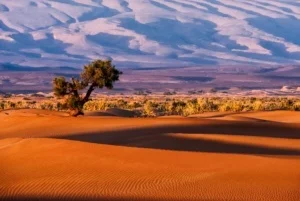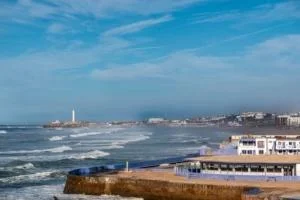Exploring Morocco
Our Travel GuideLet’s face it. We could have an entire website dedicated to Africa. Deserts. Jungles. Exotic wildlife. Incredible Archeological sites. Immense waterfalls. Beautiful beaches. These all describe Africa. One of the most interesting and incredible countries in all of Africa is Morocco. Morocco is located in a geographical and cultural crossroad. With an ethnic mix of Arabs and Amazigh, sitting at the top of the African continent and only 14 km away from Europe, also facing the Mediterranean Sea from the north and overlooking the Atlantic Ocean on the west.
The variety of Morocco doesn’t end here, but goes on further to its nature: The Atlas mountain range with the highest peak in North Africa and the Arab world. This mountain range separates the Mediterranean north, with its greenery landscapes from the Great Sahara in the south, with beautiful dunes and oases.
Amazigh tribes (Berber) are the oldest known inhabitants of North Africa. Arabs arrived to Morocco amidst the Islamic conquests in the 7th century. The Roman empire reached the country, and the Portuguese settled in port cities but Morocco remained free of every other invading force of the past from the Mongols to the Ottomans. Around the beginning of First World War, Morocco came under the control of France and Spain until it regained its independence in 1956 but you can still find traces of this occupation in the architecture, French being the second language taught in schools while northern Morocco still uses Spanish to this day.
Morocco at a Glance
Currency: The Moroccan Dirham is the official currency in Morocco. The currency code is MAD and its symbol is DH. Local / traditional shops or street vendors still use obsolete currencies such as the Franc (1 DH = 100 Franc) and Riyal (1 DH = 20 Riyal).
Visa: Visiting Morocco for less than 3 months doesn’t require a Visa for 70 countries, you can check whether your country is exempt from the list here.
Language: The official languages of Morocco are Arabic and Tamazight, representing the main two populations of the country: the indigenous Amazigh tribes who speak Tamazight and were recognized recently, while the Arabic remains the more used of the two. French is the “second” language, and is used everywhere, from road indications, restaurant menus to official documents!
- Sight Seeing 80%
- Cost 70%
- Ease of Travel 65%
- Activities 75%
“Of All The Gin Joints In All The Towns In All The World, She Walks Into Mine.” A quote from the movie Casablanca. Though filmed entirely in California including the Van Nuys Airport, Casablanca was based in Morocco. Any movie fan would love to get a drink at Rick’s Café Americain. Actually in the city of Casablanca, there is a place called Ricks Place that is a recreation of the bar from the movie. Though a bit touristy, a must-see for movie buffs around the globe.
Top Experiences in Morocco
Merzouga Desert:
Looking up the milky way from your tent in the middle of the dunes of the Great Sahara sounds beautiful, but your expectations will still be exceeded by the actual breathtaking beauty of endless dunes as far as you sight goes, the unique feeling of Merzouga’s golden red sand in your hand or under your feet, the surprisingly cool breeze and the heart-warming hospitability of the locals hosting domestic and foreign visitors.
This serenity will feel even more rewarding if you book any or all the available excursions to do in the Sahara: Jeep rides, probably with a passionate car racer that will make your heart race as well, camel rides, bonfires at night with traditional music and intriguing tales, climbing the highest dune to watch sunset and wake up early to catch sunrise with some warm tea!

Merzouga, Morocco
Chefchaouen:
This iconic city is one small, sleepy and relaxed gem located in the north of Morocco. It’s mostly known today for its photogenic alleys and laid-back mood. Despite becoming a regular destination for photography lovers and Instagram users, it still kept its candid and organic aspects.
There is no better way, or actually no other way to explore the city other than by foot. You should expect some steep stairs from time to time, and know beforehand that it’s basically a hill. But the view of the blue city from the top is very rewarding. And honestly, it isn’t really that hard to get there. The hike itself is an attraction, every little alley along the way itself is stunning, the lazy cats laying around, the locals taking on some sunlight or just chatting together in a very slow-paced, almost alternate-reality like place.
Jemaa el-Fnaa:
A truly Moroccan gathering square. You can witness here all kind of activities and shows, but the most appealing is the great variety and offers of food stalls. As the owner prepares your food in front of you, in a spectacular way, he will make sure to have a chit chat with you in English, then talk to locals in Arabic, then speak Spanish to another visitor, then greet a passing couple in Chinese. It’s probably the most energetic place in the whole of Morocco.
Complete your visit by walking to the nearby souks and check out the beauty of handmade carpets or traditional clothing, as well as the unique decorations and accessories!
Mausoleum of Mohammad V:
Rabat is often overlooked by visitors as a boring administrative city, where everything is closed by 8 pm, which is true but nonetheless, the city has so much to offer. A good start would be visiting the Mausoleum of Mohammad V and admire the very detailed internal design and decorations of the resting place of the kings of Morocco. A souvenir photo with the guards is a must when visiting the Mausoleum.
On the same ground, stand the Hassan Tower, a simple but incomplete tower overlooking the old city of Rabat, its garden and its ocean view. Kasbah of Loudaya is only a 10-minute walk downhill, you can locate it easily with the old city walls, which hide a pretty little garden inside. Inside the obscure garden, an even more hidden yet frequented little gate that takes to the most iconic café in Rabat, overlooking estuary of the main river of Rabat, Bouregreg river, and the ocean. Walk through the little alleys of the Kasbah until the top of the fort, overlooking the beach and the cliffs on the sea.
Volubilis:
These Roman city ruins in the proximity of Meknes / Fez cities, are absolutely worth a short trip from either of these cities, especially in spring when the surrounding plains are all green offering the perfect background for this historical location. Once you get there you might start wondering what happened to this ancient city and where are the missing parts of the ruins? The answers lay in a 5-minute drive from Volubilis toward the hill town of Moulay Idriss Zerhoun, where the Zawiya of this wise man (Moulay Idriss) was built by “borrowing” some of the rocks of Volubilis, which had been abandoned by then.
Both locations are extremely close and equally fascinating in completely different ways. Fez is already famous for its history as the former capital and Meknes has its many historical sites that deserve time while in the region or even midway toward the south or the north of the country.

Volubilis. Remarkable ancient Roman ruins.
Toubkal National Park:
Mt. Toubkal is the highest peak of the Atlas mountain range which extends throughout North Africa. Atlas has been historically inhabited by Amazigh/Berber tribes and so, the visit here ends up having 2 dimensions. The trek itself is great and feasible despite the rocky road. It’s more recommended to visit mid-fall or spring, when the peak is still snowy while the hike is neither too cold or too hot unlike in winter or summer. A guide will be useful to navigate you through the correct routes, and may even take you on detours to see some waterfalls and great views along the way.
What makes this trek more special is the contact with local tribes and villages, living in such a remote and difficult place, but of course keep their overwhelming generosity going on.
Tinghir:
This hidden gem is located in the southeastern of Morocco. It’s very accessible if you’re coming from or going to any major destination in the south of Morocco such as Merzouga or Ouarzazate. This little city is located between two major mountain ranges and has many flowing rivers going through the region. The drive from the foot of the city to the top is an attraction in itself, but be aware that it’s of course a winding road. One has to stop midway in the many spaces allowed to admire the amazing beauty of the Tinghir Oasis, where palm trees go on endlessly, the old Kasbah-styled houses made directly on the back of the mountains give these unique views of the region.
Before arriving to the destination, which is Todra Gorges, a minimum of 3 stops is necessary to take in the beauty of the view from the top of the mountain before checking the gorges created by the Todra river in the far past. The gorges are relatively short, but are extraordinary especially in clear days, with the contrast of the blue sky against the red gorges and the sound of the flowing water source and canal.
So for adventure head to Morocco. Here’s looking at you kid.
1 Comment
Submit a Comment
Morocco
Our Travel Blog

Discovering Kenya’s Natural Wonders: An Epic Safari Itinerary
Embark on a thrilling adventure through Kenya’s breathtaking landscapes and encounter its magnificent wildlife. From the vast plains of the Maasai Mara to the stunning peaks of Mount Kenya, this epic safari itinerary will immerse you in the wonders of nature. Get ready to witness the circle of life unfold before your eyes.

Exploring the Untouched Beauty: 5 Must-Do Activities in Uganda
Embark on a Ugandan adventure and witness the raw beauty of its landscapes. Trek through misty jungles to observe mountain gorillas, cruise the Nile at Murchison Falls, spot tree-climbing lions in Queen Elizabeth Park, marvel at Lake Bunyonyi’s serenity, and hike the snow-capped Rwenzori Mountains. Uganda’s untouched splendor awaits your discovery.

The Human Connection: Why We Should Care About People We Meet on Our Travels
“The Human Connection” explores the profound impact of human interactions during travels. It emphasizes the importance of embracing local cultures, understanding diverse perspectives, and forming meaningful connections. This post encourages readers to see beyond tourist spots and delve deeper into the heart of the places they visit, through the people they meet.




This is awesome post! Very informative. Thank you for sharing.